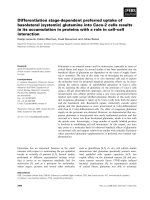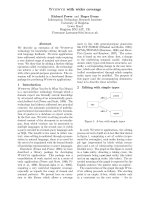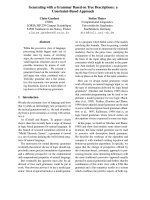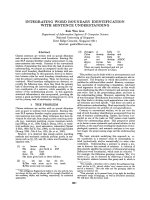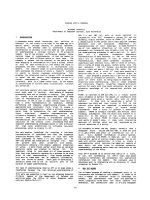Báo cáo khoa học: "Parsing with an Extended Domain of Locality" pot
Bạn đang xem bản rút gọn của tài liệu. Xem và tải ngay bản đầy đủ của tài liệu tại đây (617.56 KB, 8 trang )
Proceedings of EACL '99
Parsing with an Extended Domain of Locality
John Carroll, Nicolas Nicolov, Olga Shaumyan, Martine Smets g¢ David Weir
School of Cognitive and Computing Sciences
University of Sussex
Brighton, BN1 9QH, UK
Abstract
One of the claimed benefits of Tree Ad-
joining Grammars is that they have an
extended domain of locality
(EDOL).
We
consider how this can be exploited to
limit the need for feature structure uni-
fication during parsing. We compare
two wide-coverage lexicalized grammars
of English, LEXSYS and XTAG, finding
that the two grammars exploit EDOL in
different ways.
1 Introduction
One of the most basic properties of Tree Adjoining
Grammars
(TAGS)
is that they have an extended
domain of locality (EDOL) (Joshi, 1994). This
refers to the fact that the elementary trees that
make up the grammar are larger than the cor-
responding units (the productions) that are used
in phrase-structure rule-based frameworks. The
claim is that in Lexicalized
TAGS (LTAGs)
the el-
ementary trees provide a domain of locality large
enough to state co-occurrence relationships be-
tween a lexical item (the anchor of the elemen-
tary tree) and the nodes it imposes constraints
on. We will call this the extended domain of
locality hypothesis.
For example, wh-movement can be expressed
locally in a tree that will be anchored by a verb
of which an argument is extracted. Consequently,
features which are shared by the extraction site
and the wh-word, such as case, do not need to be
percolated, but are directly identified in the tree.
Figure 1 shows a tree in which the case feature
at the extraction site and the wh-word share the
same value)
1The anchor, substitution and foot nodes of trees
are marked with the symbols o, $ and *, respectively.
Words in parenthesis are included in trees to provide
examples of strings this tree can derive.
Much of the research on TAGS can be seen as
illustrating how its
EDOL
can be exploited in vari-
ous ways. However, to date, only indirect evidence
has been given regarding the beneficial effects of
the EDOL on parsing efficiency. The argument,
due to Schabes (1990), is that benefits to parsing
arise from lexicalization, and that lexicalization is
only possible because of the EDOL. A parser deal-
ing with a lexicalized grammar needs to consider
only those elementary structures that can be as-
sociated with the lexical items appearing in the
input. This can substantially reduce the effective
grammar size at parse time. The argument that
an EDOL is required for lexicalization is based on
the observation that not every set of trees that
can be generated by a CFG can be generated by
a lexicalized CFG. But does the EDOL have any
other more direct effects on parsing efficiency?
On the one hand, it is a consequence of the
EDOL that wide-coverage LTAGs are larger than
their rule-based counterparts. With larger ele-
mentary structures, generalizations are lost re-
garding the internal structure of the elementary
trees. Since parse time depends on grammar size,
this could have an adverse effect on parsing effi-
ciency. However, the problem of grammar size in
TAG has to some extent been addressed both with
respect to grammar encoding (Evans et al., 1995;
Candito, 1996) and parsing (Joshi and Srinivas,
1994; Evans and Weir, 1998).
On the other hand, if the EDOL hypothesis holds
for those dependencies that are being checked by
the parser, then the burden of passing feature val-
ues around during parsing will be less than in a
rule-based framework. If
all
dependencies that
the parser is checking can be stated directly within
the elementary structures of the grammar, they
do not need to be computed dynamically during
the parsing process by means of feature percola-
tion. For example, there is no need to use a slash
feature to establish filler-gap dependencies over
unbounded distances across the tree if the EDOL
217
Proceedings of EACL '99
S
$ NP[¢~ :,¢¢] S
(whom)
SNP
VP
e
Figure 1: Localizing a filler-gap dependency
makes it possible for the gap and its filler to be
located within the same elementary structure.
This paper presents an investigation into the ex-
tent to which the EDOL reduces the need for fea-
ture passing in two existing wide-coverage gram-
mars: the XTAG grammar (XTAG-Group, 1995),
and the LEXSYS grammar (Carroll et al., 1998).
It can be seen as an evaluation of how well these
two grammars make use of the EDOL hypothesis
with respect to those dependencies that are being
checked by the parser.
2 Parsing Unification-Based
Grammars
In phrase-structure rule-based parsing, each rule
corresponds to a local tree. A rule is applied to
a sequence of existing contiguous constituents, if
they are compatible with the daughters. In the
case of context-free grammar (CFG), the compat-
ibility check is just equality of atomic symbols,
and an instantiated daughter is merely the corre-
sponding sub-constituent.
However, unification-based extensions of
phrase-structures grammars are used because
they are able to encode local and non-local
syntactic dependencies (for example, subject-
verb agreement in English) with re-entrant
features and feature percolation, respectively:
Constituents are represented by DAGS (directed
acyclic graphs), the compatibility check is unifi-
cation, and it is the result of each unification that
is used to instantiate the daughters. Graph uni-
fication based on the UNION-FIND algorithm has
time complexity that is near-linear in the number
of feature structure nodes in the inputs (Huet,
1975; Ait-Kaci, 1984); however, feature structures
in wide-coverage grammars can contain hundreds
of nodes (see e.g., HPSG (Pollard and Sag, 1994)),
and since unification is a primitive operation the
overall number of unification attempts during
parsing can be very large. Unification therefore
has a substantial practical cost.
Efficient graph unification must also ensure that
it does not destructively modify the input struc-
tures, since the same rule may be used several
times within a single derivation, and also the
same constituent may be used within different
partial analyses with features instantiated in dif-
ferent ways. Copying input feature structures
in their entirety before each unification would
solve this problem, but the space usage renders
this approach impractical. Therefore, various
'quasi-destructive' algorithms (Karttunen, 1986;
Kogure, 1990; Tomabechi, 1991) and algorithms
using 'skeletal' DACS with updates (Pereira, 1985;
Emele, 1991) have been proposed, which at-
tempt to minimize copying. But even with good
implementations of the best of these improved
algorithms, parsers designed for wide-coverage
unification-based phrase-structure grammars us-
ing large HPSG-style feature graphs spend around
85-90% of their time unifying and copying feature
structures (Tomabechi, 1991), and may allocate in
the region of 1-2 Mbytes memory while parsing
sentences of only eight words or so (Flickinger,
p.c.). Although comfortably within main mem-
ory capacities of current workstations, such large
amounts of short-term storage allocation overflow
CPU caches, and storage management overheads
become significant.
In the case of unification-based LTAG the situa-
tion is even more problematic. Elementary struc-
tures are larger than productions, and the poten-
tial is that the parser will have to make copies
of entire trees and associated feature structures.
Furthermore, the number of trees that an LTAG
218
Proceedings of EACL '99
S S
$ NP[.g~ : Eli VP SNP[ w:3~g l VP
Lcase : nomj
oV[~g,:m]
SNP
oV[.g,: 3~g]
SNP
I
loves
Figure 2: Unanchored and anchored trees localizing subject/verb agreement
parser must consider tends to be far larger than
the number of rules in a corresponding phrase-
structure grammar. On the other hand, the EDOL
has the potential to eliminate some or all of feature
percolation, and in the remainder of this section,
we explain how.
An LTAG consists of a set of unanchored trees
such as the one shown on the left of Figure 2.
This shows a tree for transitive verbs where sub-
ject/verb agreement is captured directly with re-
entrancy between the value of agr feature struc-
tures at the anchor (verb) node and the subject
node. Notice the re-entrancy between the anchor
node and the substitution node for the subject.
However these are not the trees that the parser
works with; the parser is given trees that have
been anchored by the morphologically analysed
words in the input sentence. For example, the tree
shown on the right is the result of anchoring the
tree shown on the left with the word loves. An-
choring instantiates the agr feature of the anchor
node as 3sg which has the effect (due to the re-
entrancy in the unanchored tree) of instantiating
the agr feature at the subject node as 3sg.
Anchored elementary trees are translated by the
parser into a sequence of what we will refer to
as parser actions. For example, once the tree
shown on the right of Figure 2 has been asso-
ciated with the word loves in the input, it can
be recognized with a sequence of parser actions
that involve finding a NP constituent on the right
(corresponding to the object), possibly perform-
ing adjunctions at the VP node, and then finding
another NP constituent on the left (corresponding
to the subject). We say that the two NP substitu-
tion nodes and the VP node are the sites of parser
actions in this tree. Problems arise, and the EDOL
hypothesis is violated, when there is a dependence
between different parser actions.
The EDOL hypothesis states that elementary
trees provide a domain of locality large enough to
state co-occurrence relationship between the an-
chor of the tree and the nodes it imposes con-
straints on. If all dependencies relevant to the
parser can be captured in this way then, once an
elementary tree has been anchored by a particu-
lar lexical item, the settings of feature values at
all of the dependent nodes will have been fixed,
and no feature percolation can occur. Each uni-
fication is a purely local operation with no reper-
cussions on the rest of the parsing process. No
copying of feature structures is required, so mem-
ory usage is greatly reduced, and complex quasi-
destructive algorithms with their associated com-
putational overheads can be dispensed with.
Note that, although feature percolation is elim-
inated when the EDOL hypothesis holds, the fea-
ture structure at a node can still change. For ex-
ample, substituting a tree for a proper noun at
the subject position of the tree in Figure 2 would
cause the .feature structure at the node for the
subject to'include pn:+. This, however, does not
violate the EDOL hypothesis since this feature is
not coreferenced with any other feature in the tree.
3 Analysis of two wide-coverage
grammars
As we have seen, the EDOL of LTAGs makes it pos-
sible, at least in principle, to locally express de-
pendencies which cannot be localized in a CFG-
based formalism. In this section we consider two
existing grammars: the XTAG grammar, a wide-
coverage LTAG, and the LEXSYS grammar, a wide-
coverage D-Tree Substitution Grammar (Rambow
et al., 1995). For each grammar we investigate the
extend to which they do not take full advantage
of the EDOL and require percolation of features at
parse time.
There are a number of instances in which depen-
dencies are not localized in the XTAG grammar,
most of which involve auxiliary trees. There are
219
Proceedings of EACL '99
three types of auxiliary trees: predicative, modi-
fier and coordination auxiliary trees. In predica-
tive auxiliary trees the anchor is also the head of
the tree and becomes the head of the tree resulting
from the adjunction. In modifier auxiliary trees,
the anchor is not the head of the tree, and the sub-
tree headed by the anchor usually plays a role of
adjunct in the resulting tree. Coordination auxil-
iary trees are similar to modifier auxiliary trees in
that they are anchored by the conjunction which
is not the head of the phrase. One of the conjoined
nodes is a foot node, the other one a substitution
node.
3.1 Modifier Auxiliary Trees
In modifier auxiliary trees an example of which
is shown in Figure 32 the feature values at the
root and foot nodes are set by the node at which
the auxiliary tree is adjoined, and have to be per-
colated between the foot node and the root node.
The LEXSYS grammar adopts a similar account of
modification.
From a parsing point of view, this does not re-
sult in the need for feature percolation: only the
foot node of the modifier tree is the site of a parser
action, and the root node is ignored by the process
that interprets the tree for the parser.
3.2 Coordination Auxiliary Trees
An example of an XTAG coordination auxiliary
tree is shown on the left of Figure 4. This case is
different from the modification case since features
of the substitution node have to be identical to fea-
tures of the foot node (which wiIl match those at
the adjunction site). From a parsing point of view
these nodes are both the sites of actions, resulting
in the need for feature percolation. For example,
for the NP coordination tree shown in Figure 4,
if one of the conjuncts is a wh-phrase, the other
conjunct must be a wh-phrase too, as in who or
what did this? but *John and who did this? The
wh-feature has to be percolated between the two
nodes on each side of the conjunction.
In the LEXSYS grammar, a coordination tree is
anchored by a head of the tree, not by the con-
junction. To illustrate (see the tree on the right
of Figure 4), N P-coordination trees are anchored
by a noun, and features such as wh and case are
ground during anchoring. As a result, there is no
need for passing of these features in the coordina-
tion trees of the LEXSYS grammar.
2All examples relating to the XTAG grammar come
from the XTAG report (XTAG-Group, 1995). They
have been simplified to the extent that only details
relevant to the discussion are included.
As for agreement features, there are two cases
to consider: if the conjunction is and, the number
feature of the whole phrase is plural; if the con-
junction is or, the number feature is the same as
the last conjunct's (XTAG-Group, 1999). In both
the XTAG and LEXSYS grammars, this is achieved
by having separate trees for each type of conjunc-
tion.
3.3 Predicative Auxiliary Trees
In the XTAC grammar, subject raising and aux-
iliary verbs anchor auxiliary trees rooted in VP,
without a subject3; they can be adjoined at the
VP node of any compatible verb tree. With this
arrangement, subject-verb agreement must be es-
tablished dynamically. The agr feature of the NP
subject must match the agr feature of whichever
VP ends up being highest at the end of the deriva-
tion. In Figure 5, the bought tree has been an-
chored in such a way that adjunction at the VP
node is obligatory, since a matrix clause cannot
have mode:ppart. 4 When the tree for has is ad-
joined at the VP node the agr features of the sub-
ject will agree with those of bought. The feature
structure at the root of the tree for has is unified
with the upper feature structure at the VP node
of the tree for bought, and the feature structure
at the foot of the tree for has is unified with the
lower feature structure at the VP node of the tree
for bought. The foot node of the has tree is the VP
node on the frontier of the tree. Note that even
after the tree has been anchored, re-entrancy of
features occurs in the tree.
Thus, there are two sites in the tree for bought
(the subject NP node and the VP node) at which
parser actions will take place (substitution and
adjunction, respectively) such that a dependency
between the values of the features at these two
nodes must be established by the parser.
The situation is similar for case assignment
(also shown in the Figure 5): the value of a fea-
ture ass-case (the assign case feature) on the high-
est VP is coreferred with the value of the feature
case on the subject NP. For finite verbs, the value
of the feature ass-case is determined by the mode
of the verb. For infinitive verbs, case is assigned
in various ways, the details of which are not rele-
vant to the discussion here. The subject is in the
nominative case if the verb is finite, and in the
accusative otherwise. As with the agr feature, the
value of the case feature cannot be instantiated
3To allow for long distance dependency, subject
raising verbs must anchor an auxiliary tree, with iden-
tical root and foot nodes, a VP.
4Unifying the two feature structures at the VP node
would cause a matrix clause to have mode:ppart.
220
Proceedings of EACL '99
Nm
o Adj
•
NI~
I
red
Figure 3:
XTAG
example of modifying auxiliary tree
f
* NP[=~ m~]
oConj
. NP[ Wh:
I
and
Np[ ~h:- 1
s N p
,t.
Conj
NP
oNF h:
Lcase .' nora/ace]
apples
Figure 4: Coordination in XTAG (left) and LEXSYS (right)
in the anchored elementary tree of the main verb
because auxiliary verb trees can be adjoined.
The same observations apply to the XTAG treat-
ment of copula with predicative categories such as
an adjective. As shown in Figure 6, these pred-
icative AP trees have a subject but no verb; trees
for raising verbs or the copula can be adjoined
into them. As in the previous example, the agr
features of the verb and subject cannot be instan-
tiated in the elementary tree because the verb and
its subject are not present in the same tree.
From the examples we have seen, it appears that
the XTAG grammar does not take full advantage
of the EDOL with respect to a number of syntactic
features, for example those relating to agreement
and case. The LEXSYS grammar takes a rather dif-
ferent approach to phenomena that XTAG handles
with predicative auxiliary trees.
The
LEXSYS
grammar has been designed to lo-
calize
syntactic
dependencies in elementary trees.
As in the XTAC grammar, unbounded dependen-
cies between gap and filler are localized in elemen-
tary trees; but unlike the XTAG grammar, other
types of syntactic dependencies, such as agree-
ment, are also localized. All finite verbs, including
auxiliary and raising verbs, anchor a tree rooted
in S, and thus are in the same tree as the subject
with which they agree. An example involving fi-
nite verbs is shown in Figure 7. Since verb trees
cannot be substituted between the subject and the
verb, the agr feature can be grounded when ele-
mentary trees are anchored, rather than during
the derivation. The case feature of the subject
can be specified even in the
unanchored
elemen-
tary tree: in trees for finite verbs the subject has
nominative case; in trees for
for to
clauses it
has accusative case.
As can be seen from the tree on the right of
Figure 7, subject raising and auxiliary verbs are
rooted in S and take a VP complement. So the
sentence
He seems to like apples
is produced by
substituting a VP-rooted tree for
to like
into a tree
for
seems.
Thus, for all three trees shown in Figure 7,
once anchoring has taken place, all of the syn-
tactic features being checked by the parser are
grounded. Hence, the parser does not have to
check for dependencies between the parser actions
taking place at different sites in the tree.
3.4 Semantic Dependencies
There are many examples where the ×TAG gram-
mar, but not the LEXSYS grammar, localizes se-
mantic dependencies: for example, dependencies
221
Proceedings of EACL '99
S[modo: ]]
$ NP [:g:o::[~]
vP L:o%: T° mJ
~.~~rnode : ppart]
I
bought
fagr
:
3sg
"1
.ore /
L : o:Th :omj., oo d
has
Figure 5: XTAG example with a raising verb
S [mode : I~1]
,I.NP - VP [m°~
oV[mooo:,o ]
,vP
I
I
I
e o Adv
is I
upset
Figure 6:
XTAG
example of a predicative adjective
between an adjective and its subject. As shown in
Figure 6, in
XTAG
the predicative adjective and its
subject are localized in the same elementary tree,
and selectional restrictions can be locally imposed
by the adjective on the subject without the need
for feature percolation. On the other hand, in the
LEXSYS grammar, the dependency between upset
and he in he looks upset could not be checked dur-
ing parsing without the use of feature passing be-
tween the subject and AP node of the tree in the
middle of Figure 7.
3.5 Percolation of Features in
LEXSYS
This section considers a limited number of cases
where it appears that it is not possible to set
all syntactic features by anchoring an elementary
tree.
When two nodes other than the anchor of the
tree are syntactically dependent, feature values
may have to be percolated between these nodes
(the anchor does not determine the value of these
features). For example, in English adjectives that
can have S subjects determine the verb form of the
subject. Hence, in Figure 8, the verb form feature
of the subject is not determined by the anchor
of the tree (the verb) but by the complement of
the anchor (the adjective). The verb form feature
must therefore be percolated from the adjective
phrase to the subject.
The XTAG grammar localizes this dependency
(see Figure 6). However, as we have seen, agree-
ment features are not localized in this analysis.
The problem then is that it does not seem to be
possible to localize all syntactic features in this
case.
Feature percolation is also required in the
LEXSYS grammar for prepositional phrases which
contain a wh-word, because the value of the wh
feature is not set by the anchor of the phrase (the
preposition) but by the complement (as in these
reports, the wording on the covers of which has
caused so much controversy, are to be destroyed5 ).
The value of the feature wh is set by the N P-
complement, and percolated to the root of the PP.
4 Conclusions
In XTAG both syntactic and semantic features are
considered during parsing, whereas in the LEXSYS
5Example borrowed from Gazdar et al. 1985.
222
Proceedings of EACL '99
S S
$ NP [~":
3,, ] VP $ NP
[~e: 3'~ml
VP
Lcase
:
nomj
Vi ''g' : 3'g
] SNP
o V L,.,o,~ : i,,,~j
o ['g': 3,g l ,L AP
Lmocle
: indJ I
I
likes looks
S
SNP[:~
<>V[~g, : 3,g
]
Lmode : indj
.,~ VP [mode : inf]
seems
Figure 7: LEXSYS example for case and agr features
S
SS[mo
oV ragr : 3sg ] $ J~P [subj : mode : [~]]
j Lmode
: indJ
looks
Figure 8: LEXSYS example for subject/adjective syntactic dependency
system only syntactic dependencies are considered
during parsing; semantic dependencies are left
for a later processing phase. The LEXSYS parser
returns a complete set of all syntactically well-
formed derivations. Semantic information can
be recovered from derivation trees and then pro-
cessed as desired.
From a processing point of view, the XTAG and
LEXSYS grammars are examples that show that
the checking of dependencies involves a trade-off. 6
On the one hand, a greater number of parses may
be returned if the only dependencies checked are
syntactic, since possible violations of semantic de-
pendencies are ignored. On the other hand, as
we have seen in this paper, there are potentially
substantial benefits to parsing efficiency if all de-
pendencies that the parser is checking can be lo-
calized with the EDOL. It is tOO early to say how
best to make the trade-off, but by comparing the
way that the XTAG and LEXSYS grammars exploit
the EDOL, we hope to have shed some light on
the role that the EDOL can play with respect to
parsing efficiency.
6These are both grammars for English. Hence,
whether the conclusions we draw apply to other lan-
guages is outside the scope of the present work.
5 Acknowledgements
This work is supported by UK EPSR.C project
GR/K97400 and by an EPSRC Advanced Fellow-
ship to the first author. We would like to thank
Roger Evans, Gerald Gazdar & K. Vijay-Shanker
for helpful discussions.
References
Hassan Ait-Kaci. 1984. A Lattice Theoretic Ap-
proach to Computation Based on a Calculus of
Partially Ordered Type Structures. Ph.D. the-
sis, Department of Computer and Information
Science, University of Pennsylvania, Philadel-
phia, PA.
Marie-H~l~ne Candito. 1996. A principle-
based hierarchical representation of LTAGs.
In Proceedings of the 16th International Con-
ference on Computational Linguistics, Copen-
hagen, Denmark, August.
John Carroll, Nicolas Nicolov, Olga Shaumyan,
Martine Smets, and David Weir. 1998. The
LEXSYS Project. In Proceedings of the
Fourth International Workshop on Tree Adjoin-
ing Grammars and Related Frameworks, pages
29-33.
223
Proceedings of EACL '99
Martin Emele. 1991. Unification with lazy non-
redundant copying. In Proceedings of the 29th
Meeting of the Association for Computational
Linguistics, pages 323-330, Berkeley, CA.
Roger Evans and David Weir. 1998. A structure-
sharing parser for lexicalized grammars. In Pro-
ceedings of the 36th Meeting of the Association
for Computational Linguistics and the 17th In-
ternational Conference on Computational Lin-
guistics, pages 372-378.
Roger Evans, Gerald Gazdar, and David Weir.
1995. Encoding lexicalized Tree Adjoining
Grammars with a nonmonotonic inheritance hi-
erarchy. In Proceedings of the 33rd Meeting of
the Association for Computational Linguistics,
pages 77-84.
G. P. Huet. 1975.
typed A-calculus.
ence, 1:27-57.
A unification algorithm for
Theoretical Computer Sci-
Aravind Joshi and B. Srinivas. 1994. Disambigua-
tion of super parts of speech (or supertags): Al-
most parsing. In Proceedings of the 15th Inter-
national Conference on Computational Linguis-
tics, pages 154-160.
Aravind Joshi. 1994. Preface to special issue on
Tree-Adjoining Grammars. Computational In-
telligence, 10(4):vii-xv.
Lauri Karttunen. 1986. D-PATR: A development
environment for unification-based grammars.
In Proceedings of the 11th International Confer-
ence on Computational Linguistics, pages 74-
80, Bonn, Germany.
Kiyoshi Kogure. 1990. Strategic lazy incremen-
tal copy graph unification. In Proceedings of
the 13th International Conference on Compu-
tational Linguistics, pages 223-228, Helsinki.
Fernando Pereira. 1985. A structure-sharing rep-
resentation for unification-based grammar for-
malisms. In Proceedings of the 23rd Meeting of
the Association for Computational Linguistics,
pages 137-144.
Carl Pollard and Ivan Sag. 1994. Head-Driven
Phrase Structure Grammar. University of
Chicago Press, Chicago.
Owen Rambow, K. Vijay-Shanker, and David
Weir. 1995. D-Tree Grammars. In Proceed-
ings of the 33rd Meeting of the Association for
Computational Linguistics, pages 151-158.
Yves Schabes. 1990. Mathematical and Computa-
tional Aspects of Lexicalized Grammars. Ph.D.
thesis, Department of Computer and Informa-
tion Science, University of Pennsylvania.
Hideto Tomabechi. 1991. Quasi-destructive
graph unification. In Proceedings of the 29th
Meeting of the Association for Computational
Linguistics, pages 315-322, Berkeley, CA.
The XTAG-Group. 1995. A lexicalized Tree Ad-
joining Grammar for English. Technical Report
IRCS Report 95-03, The Institute for Research
in Cognitive Science, University of Pennsylva-
nia.
The XTAG-Group. 1999. A lexicalized Tree
Adjoining Grammar for English. Technical
Report http://www, cis. upenn, edu/-xtag/
tech-report/tech-report, html, The In-
stitute for Research in Cognitive Science,
University of Pennsylvania.
224
